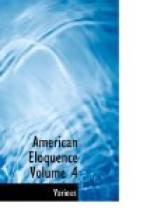On January 14, 1875, the “Resumption Act” was passed. It declared that “on and after January 1, 1879, the Secretary of the Treasury shall redeem in coin the United States legal-tender notes then outstanding, on their presentation for redemption at the office of the Assistant Treasurer of the United States in the city of New York, in sums of not less than fifty dollars.” The same Act provided that while the legal-tender notes outstanding remained in excess of $300,000,000, the Secretary of the Treasury should redeem such notes to the amount of 80 per cent. of the increase in National Bank notes issued.
On May 31, 1878, an Act was passed forbidding the further retirement of United States legal-tender notes, and providing that “when any of said notes may be redeemed or be received into the Treasury under any law from any source whatever and shall belong to the United States, they shall not be retired, cancelled, or destroyed, but they shall be re-issued and paid out again and kept in circulation.” When this Act was passed there were $346,681,016 of United States notes outstanding, and there has been no change in the amount since.
As to the silver policy of the Government since the war it is expected that the purport of certain important acts of legislation should be understood by all who would have an intelligent conception of our financial controversies.
The Act of February 12, 1873, suspended the coinage of the standard silver dollar of 412 and 1/2 grains. This Act authorized the coinage of the trade dollar of 420 grains, making it a legal tender for $5. This is the Act which has been called the “crime of 1873,” on which tomes of controversy have been called forth. It is discussed at some length in the speech of Mr. Morrill, found in our text.
On February 28, 1878, the Bland-Allison Act was passed over the veto of President Hayes. A bill providing for the free and unlimited coinage of silver, of 412 and 1/2 grains to the dollar, had passed the House in November, 1877, under a suspension of the rules. At this time the bullion in the silver dollar was worth about 92 cents. When the Bland free-coinage Act came to the Senate, it was amended there on report of Senator Allison, of Iowa, Chairman of the Finance Committee of the Senate, by a provision that the Government should purchase from $2,000,000 to $4,000,000 worth of silver bullion for coinage into dollars. Holders of the coin were authorized to deposit the same with the United States Treasurer and to receive therefor certificates of deposit, known as silver certificates. These certificates are not legal tender, although receivable for customs, taxes, and all public dues, and are redeemable only in silver. This Act called forth an exhaustive and able debate. Senator Morrill, of Vermont, opened the debate in opposition to silver coinage. Senator Beck, of Kentucky, was one of the ablest advocates of silver coinage, while Mr. Blaine made a notable contribution to the




